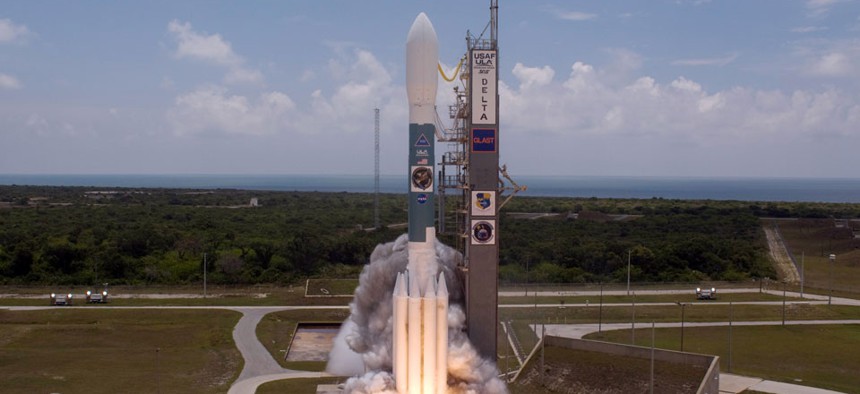Climate Change Is Making It Harder to Get to Space
NASA says rising sea levels threaten launch facilities.
Climate change won't just wreak havoc here on Earth—it's going to make it harder to leave.
According to the National Aeronautics and Space Administration, rising sea levels and extreme storms from climate change pose a risk to the nation's launch facilities, most of which are along coastlines. For example, NASA's Kennedy Space Center in Florida is likely to see heavier rains and more flooding, which could not only imperil infrastructure but close the window for launch days.
Overall, two-thirds of NASA's assets, the agency said, are imperiled by beach erosion, on top of the vast information and energy infrastructure that could be affected by brownouts or blackouts. And an already-strained budget and "degraded" infrastructure could make it difficult for the space agency to catch up.
That's among the findings in a series of reports released Friday by the White House five years after President Obama ordered the federal government—the nation's largest energy consumer—to cut greenhouse-gas emissions 28 percent by 2020 and adapt to climate change. According to the Council on Environmental Quality (CEQ), federal agencies have already slashed emissions by 17 percent since 2008, the equivalent of taking 1.8 million cars off the road.
But the reports also lay out risk for the agencies as the climate continues to change. The National Parks Service warns that the "iconic features or resources" of national parks could vanish, including the Joshua trees at Joshua Tree National Park or the glaciers of Glacier National Park.
The Agriculture Department, for example, says that warming temperatures could as much as double the number of acres at risk of wildfires by 2050, straining resources and firefighting capabilities. And the Health and Human Services Department projects an increased risk of vector-borne diseases like West Nile, allergens, and even the introduction of "novel, exotic diseases."
Even the asphalt in highways and the rails on train tracks managed by the Transportation Department could break down, meaning more repairs and delays.
The agencies also Friday collected their annual sustainability plans, which detailed strategies to reduce energy consumption and use resources more efficiently. It's been a priority for the administration, with the General Services Administration taking steps to introduce alternative fuel cars to the government's vehicle fleet and make agencies' massive buildings more efficient.
Individual agencies, however, are now required to craft their own plans. The Environmental Protection Agency, for example, said it will reduce the heating and cooling demand at federal labs, as well as switching its airflow systems to be more efficient. The Federal Bureau of Investigation is crafting its own sustainable design and construction standards that it says can exceed current standards by 30 percent.
The U.S. Postal Service has been working for years to make its 200,000-plus vehicle fleet more efficient, including a consolidation of delivery plans that axed some 1,800 routes last year. Still, the agency said that its fuel consumption demands increased with the addition of new delivery points even as its overall energy consumption from its 32,000 buildings nationwide dropped.
Overall, CEQ said, agencies are on pace or ahead of schedule on many sustainability goals, including a 19 percent drop in water use since 2007 and getting 9 percent of energy from renewable sources.
"These agency climate plans underscore the Administration's commitment to leading by example throughout the Federal Government so we can leave behind a planet that is not polluted and damaged and protect our ability to provide the vital services American communities depend on," said CEQ director Mike Boots.
For the full suite of vulnerability and adaptation reports, see the CEQ website.
NEXT STORY: What to Expect From Procurement in 2015



